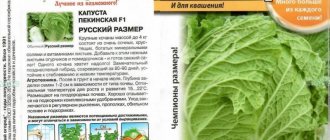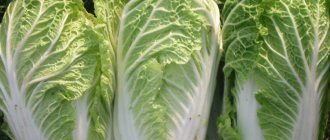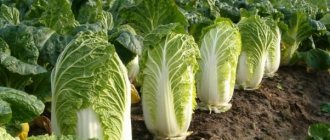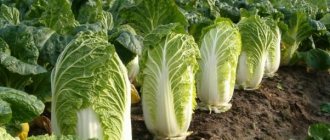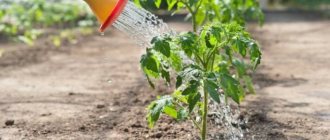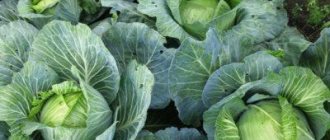Chinese cabbage varieties are characterized by a variety of varieties.
Although, until 1970, cabbage was little known in Russia and was considered exotic. But during this time, Russian breeders have developed many varieties adapted to certain regions of the Russian Federation. At the moment, the situation has changed radically, and now more and more of our domestic summer residents and gardeners are planting Chinese cabbage. Most cabbage varieties are distinguished by their unpretentiousness, ease of care and early ripening. And it is difficult for a novice gardener to understand this diversity. Later in the article, we will learn in more detail about the best varieties of Chinese cabbage. Go?
Description of Chinese cabbage
China, according to official data, is considered the birthplace of Chinese cabbage. Pekinka has been actively grown there since the 5th century. And then, it began to spread throughout the world. In the vastness of Russia, Chinese cabbage gained recognition only after 1970.
Chinese cabbage is popularly called “Chinese salad”, and sometimes simply “salad cabbage”. It can be leafy (half-headed) or cabbage-shaped. By the way
, the cabbage form is more popular among the people. Here, loose cylindrical heads of cabbage are obtained, which consist of elongated and fibrous leaves. At the same time, the leaves have sparse and soft veins. The outside of the head of cabbage has a rich green color, and the inside is yellow or green with yellowish tint. The mass of cabbage ranges from 1.2 kg to 4 kg, depending on the type of Chinese cabbage.
High yields can only be achieved if all agronomic practices are followed. For example, such as:
- The optimal temperature for growing Pekinka is considered to be 13 °C - 20 °C.
- Daylight hours should be less than 12 hours. And if it is more than 13 hours, then the plant will go into arrow (bloom).
- The superficial root system cannot take moisture from the depths, which means you need to water regularly to ensure that the top layer of soil is always moist.
- Regular fertilizing keeps the soil fertile.
On a note!
If these agronomic techniques are not followed, then the cabbage may simply stop growing, and then you can’t count on a large harvest.
Classification of cabbage varieties
The choice of Chinese cabbage variety is important. And this is because different varieties behave differently in different climate zones. At the same time, all varieties can have both positive and negative sides; we must choose them based on our preferences. Important
: The best varieties are those that are productive, resistant to bolting and diseases.
Classification by ripening time
:
- early ripening;
- mid-season;
- late ripening.
On a note!
In the article, the ripening dates are indicated approximately because the growing process is influenced by various factors, especially the weather. Therefore, here you need to proceed from certain conditions. In different regions, on different lands, the harvest can vary dramatically.
And there are also varieties that are resistant to flowering. And they will also be discussed later in the article.
Beneficial features
The Chinese, like no other, know a lot about proper nutrition. This amazing nation tries to include in its diet only those foods that will benefit the body. That is why pak choi cabbage was appreciated by them many centuries ago, and enjoys well-deserved popularity to this day.
Chinese cabbage is a great choice for people trying to lose weight. After all, the culture not only contains a minimum of calories, it also helps burn fat.
People in the Celestial Empire have long been aware of the amazing healing properties of cabbage. Chinese doctors recommend their patients to use pak choy for various diseases of the gastrointestinal tract, vascular diseases and even heart diseases. The vegetable is often used to treat anemia.
The bactericidal properties of cabbage make it possible to use it for the speedy healing of burns, wounds and even ulcers.
The bactericidal properties of cabbage allow it to be used for wound healing
Pak choy contains an incredibly large amount of vitamins, minerals, micro- and macroelements.
Important! Pak choi is highly recommended for women expecting a baby. The vegetable contains folic acid, which is so necessary during pregnancy. It has been scientifically proven that eating Chinese cabbage in all trimesters prevents the occurrence of defects in the fetus.
Early maturing varieties of Chinese cabbage
Cabbage varieties that ripen within 2 months after germination are early ripening. Here there is a dependence of the ripening time on each individual variety. Chinese cabbage can be ready for harvesting in 30, 35, 40, 50, 55 days. Any cabbage with such terms is considered early (40 - 60 days). Important
: usually early-ripening Peking cabbage has loose and light heads, and this directly depends on the structure of the leaves.
On a note!
Early cabbage does not store well due to the looseness of the heads.
The most popular varieties
: Richie F1 (mid-early), Stonefly, Beijing broadleaf, Semi-headed, TSHA 2, Lenok F1, Russian size, Cha-Cha F1, Orange mandarin, Yuki F1, Alyonushka (leaf, pak choi), Little miracle F1, Miss China, Manoko F1, Custar F1.
Cha-Cha F1
.
An early ripening hybrid, ripening in 45 - 55 days. The heads of cabbage are round and cylindrical in shape with bright green outer leaves that have wide veins. When cut, you can see yellow flesh with excellent taste, which is characterized by tenderness and juiciness. Important
: carotene content - 3.8 mg per 100 g, vitamin C - up to 38 mg. Moreover, cabbage can withstand drought and is resistant to flowering. Under optimal conditions, it is possible to keep the vegetable fresh for 3 - 3.5 months.
Little miracle F1
. An ultra-early ripening hybrid that ripens within 28 - 32 days. Weight of forks - 0.4 kg - 0.6 kg, outer color - rich green, leaves - broadly oval, bubbly with large cream-colored veins. The density of the tussocks is average. Cabbage is not suitable for storage, so it is used immediately after harvesting.
Manoko F1
. An early ripening hybrid from Holland, ripening 50 days after germination. A medium-sized rosette with wide and bubbly green leaves. The leaf vein is flat, white and wide. The head of cabbage is elongated in shape - barrel-shaped, and can weigh 1 kg - 1.5 kg. Inside there is pale yellow flesh of medium density. The advantages are resistance to shooting and heat resistance. And yet, heads of cabbage can be stored in the refrigerator after harvesting for 2 - 3 months.
Growing Beijing seedlings
To obtain maximum early harvest, gardeners practice growing Chinese cabbage seedlings. Such agricultural technology allows you not only to get juicy, tasty greens as quickly as possible, but also to harvest 2-3 crops during the warm season. Peking seedlings are planted in the second half of April; usually already in the first ten days of May, such grown seedlings are transferred to open ground and literally after 3-4 weeks they receive their first harvest.
This plant does not like picking and transplanting, so you need not only to choose the right time for planting it, but also to use peat pots or separate cassettes for growing seedlings. Usually two or three seeds are planted in each individual container, subsequently leaving only the strongest powerful sprout.
After the first shoots appear, the pots or cassettes are transferred to a well-lit room with a temperature of no more than 18 degrees. At higher temperatures, the plants quickly stretch out, and in the future it will be impossible to get a good harvest from them. Seedlings should be transplanted into the garden bed together with a lump of earth, which prevents injury to the root system.
Holes for planting Chinese cabbage seedlings are made at a distance of 30 centimeters from each other, adding a pinch of complex mineral fertilizers and half a glass of ash to the bottom. It would not be superfluous to cover the young plants with film for the first few days after transplantation, which prevents damage to the Chinese cabbage by sudden temperature changes.
Late-ripening varieties of Chinese cabbage
Late-ripening varieties of Chinese cabbage ripen within 80 - 90 days or more. Such varieties are characterized by the ability to be stored for a long time. And this is due to the denser structure of the leaves and central veins. Accordingly, the heads of cabbage are denser. Important
: It is advisable to grow late-ripening varieties only in warm regions, otherwise they simply will not have time to ripen.
Read more about how to store Chinese cabbage in this article.
On a note!
Some late varieties of cabbage differ slightly from mid-late varieties (75 - 80 days), so we choose based on our preferences. In some sources, mid-late varieties are classified as late, and there is no big mistake in this.
The best varieties of Beijing
: Nika F1, Monument, Turquoise F1, Russian size F1.
Nika F1
.
A hybrid with a late ripening period, and here the first harvest is harvested after 75 - 80 days. The rosette of leaves is vertical, its size is medium, the leaves are green and wrinkled with a waxy coating. The heads of cabbage are oval in shape with a thickening at the bottom, dense, closed, weighing 2 kg - 3 kg. When cut, you can see yellow flesh and a medium-length stalk. Value
: excellent taste, aligned heads of cabbage, unpretentiousness, excellent immunity, possibility of growing throughout Russia. Storage - in the refrigerator for 3 months.
Russian size F1
.
A late-ripening hybrid bred by Russian breeders, and ripening within 80 - 90 days. The variety is characterized by its bright green color, juiciness, broadly rounded leaves, and they are corrugated with cream-colored veins. The heads of cabbage are all smooth, their shape resembles a wide cylinder, and their consistency is dense. Weight - up to 4 kg, taste excellent. Among the advantages are
: cold resistance, drought resistance, the ability to grow in all regions, versatility in use.
Turquoise F1
.
The hybrid ripens in 80 - 90 days, so it is considered late. A medium-sized rosette of leaves that has large, wrinkled, oval-shaped leaves with large, wide, concave veins. The heads of cabbage are oval, and when cut they have a cream color. The pulp is dense. Weight - on average 1.2 kg. By the way
, the harvest can be stored until January.
Use for diseases
The usefulness of Chinese cabbage is higher in its raw form. For better absorption, a small amount of vegetable oil is added to the fresh vegetable.
Digestive diseases
Peking juice is drunk instead of tea when heartburn and nausea occur. The drink has an astringent effect and relieves inflammation.
Dishes for a patient with gastritis are prepared without spices; no salt, bay leaf, pepper, lemon juice or vinegar are added.
Peking cabbage for pancreatitis is allowed in small quantities from 3 weeks from the onset of exacerbation of the disease. The product is used for preparing first courses, served stewed or boiled. During the period of stable remission between periods of exacerbation, gradual introduction of fresh vegetables into the diet is allowed.
Joint inflammation
Chinese cabbage is allowed for gout as a therapeutic and prophylactic product. Consumed fresh, boiled and stewed.
The vegetable helps normalize metabolism and maintain the acid-base balance. Activates the removal of excess salts and uric acid compounds from the body, reduces the symptoms of gouty changes.
In folk medicine, in addition to eating pekinka, it is recommended to make compresses from the vegetable for inflamed joints. Apply fresh leaves to sore spots and secure with a bandage.
In China, petsai is considered a means of prolonging the youth of joints and the body as a whole.
Varieties resistant to flowering
Peking cabbage is a cold-resistant plant, but at the same time, if the cabbage is exposed to low temperatures, then there is a possibility that it will go into bloom (bloom). In general, cabbage can bloom in any worsening weather conditions. For example, when daylight hours increase or when temperatures rise above normal. By the way
, the flowering of Chinese cabbage significantly affects the yield, and this is because instead of growing a head of cabbage, the cabbage spends its energy on producing seeds. There are universal varieties that have many useful qualities (except for resistance to flowering), and they have already been mentioned above.
The best varieties that can resist flowering
: Champion, Manoko, Mirako, Optiko, Bilko, Kewstar, Gilton, Victoria, Marfa, Hydra.
Champion
.
A mid-season variety that ripens within 60 - 70 days. The outer leaves are yellow-green. The heads of cabbage are closed, dense, weighing on average 1.5 kg - 2 kg. Productivity - 9 kg - 12 kg per 1 sq. m plot. Among the advantages are
: resistance to bolting and a closed top. And also, the ability to be stored until the New Year, while it is important that optimal conditions are maintained.
Miraco
.
Ripens in 50 - 52 days, therefore it is considered early ripening. The rosette of leaves is medium in size, and here the leaves have a broad oval shape. At the same time, they are also bubble (corrugated). The heads of cabbage have: light green color, barrel-shaped, weight - 1 kg - 1.5 kg. When cut, you can see the dense and juicy pulp of a creamy white color. Used mainly for fresh consumption. The advantages
are resistance to bolting, good immunity and evenness of heads of cabbage.
Victoria F1
.
Mid-season hybrid, ripening in 65 - 70 days. It has heads of cabbage weighing 1.2 kg - 2 kg, dense. And on the cut you can see the yellowish flesh, which is juicy, dense and tasty. The purpose is universal. Value of the variety
: resistance to flowering, possibility of long-term storage, suitable for all regions..
Plant care
When caring for Chinese cabbage, it is recommended to adhere to some simple but important rules that will allow you to achieve a high and high-quality harvest.
Fertilizer regime and watering
Abundant and timely watering is one of the main points of successful vegetable growth. Cabbage responds positively to ample moisture, which should be done every 7 days. The plant is watered at the root using settled, warm water; this is done on cloudy days, morning or evening. When carrying out irrigation activities, you need to ensure that moisture does not fall on the foliage, otherwise yellow, dry spots will form on it.
Important! Do not allow moisture to stagnate in the soil, as this can cause rotting of the root system.
For the full development of the “Asian”, it needs to organize feeding, the first of which is recommended 2 weeks after planting the seedlings in the ground. To feed the vegetable, nitrogen-containing preparations are used at the rate of 10 g of product per 1 m² of soil. It is very important not to overdo it with nitrogen fertilizers, since their increased content in the soil can provoke plant diseases.
During the entire growing season, the crop needs to be fed 3-4 times, while 2 feedings can be done using a mullein solution. Foliar feeding with boric acid has a positive effect on the formation of heads of cabbage, so they should also be carried out several times a season.
Loosening the soil
Since cabbage prefers to grow on light, breathable soils, it is necessary to regularly carry out the loosening procedure, which will allow:
- enrich the soil with oxygen and nutrients required for plant growth;
- activate the growth of the root system.
Be careful not to let soil fall on the apical bud. At the same time, it is recommended to weed weeds, which inhibit the full development of the crop and take away vital substances from it.
It is recommended to carry out loosening shallowly. 2 weeks after planting the seedlings, you can mulch the soil around the bushes with a layer of straw, hay or sawdust. Mulching will make it possible to prevent the evaporation of moisture from the soil and will prevent the growth of weeds.
Pest and disease control
Chinese cabbage has a fairly strong immunity to many diseases, but in some cases it can become a “victim” of pests, which include:
- Cruciferous flea beetle. The parasite feeds on cabbage leaves, as a result of which small holes-holes are first formed on the leaf plate, which later transform into solid holes. To combat fleas, treat the crop with garlic infusion, wood ash or tobacco dust.
- Aphid. The main food for the insect, which “settles” on the underside of the leaf, is cabbage juice. A dehydrated plant quickly loses strength and energy, as a result of which it withers, becomes deformed and lags behind in development. Spraying the leaves with infusion of tobacco or onion is excellent for killing the parasite.
- Slugs. Pests are dangerous because they eat almost all parts of the vegetable, as a result of which it can die. To avoid crop loss, the soil around the bushes should be covered with a mixture of wood ash, red pepper, salt and mustard powder.
When growing Chinese cabbage, many vegetable growers may encounter a number of difficulties associated with violations of the basic rules of agricultural technology:
- Black dots on the leaf plate. The cause of their appearance may be a fungal disease caused by conidia fungus or a metabolic disorder.
- Shooting and formation of inflorescences. Cabbage begins to bloom and form arrows due to any stress: irregular watering, overheating, lack of light in spring, etc. In order to avoid such problems, it is recommended not to expose the crop to stressful situations, and also for planting choose hybrid varieties of cabbage that are not susceptible to bolting and flowering.
- Doesn't tie stalks . In order for the vegetable to form a dense head, you can regularly spray it with a solution of boric acid, at the rate of 2 g per 10 liters of water.
Simple but very effective preventive measures will help prevent the development of various ailments and the appearance of parasites:
- timely removal of weeds;
- regular weeding of the soil;
- control of soil moisture;
- preventive spraying of plants with insecticidal and fungicidal preparations.
Did you know? The birthplace of Chinese cabbage is the People's Republic of China, where the vegetable began to be cultivated more than 5 thousand years ago. But in Japan, the crop is used not only as a tasty vegetable, but also as an ornamental plant in landscape design.
Zoning varieties
Until now, novice Russian summer residents and gardeners considered Chinese cabbage exotic. But at the moment, no one thinks so, and everyone knows that cabbage can be successfully grown throughout almost the entire territory of the Russian Federation. And this is thanks to the new varieties that Russian breeders developed. By the way
, new varieties of Chinese cabbage are bred specifically for certain regions.
Next will be listed varieties that can be grown in the Middle Zone, Siberia and the Urals. Important
: greenhouses are used to grow early cabbage in Siberia, and all the varieties that grow there can be safely grown in the middle zone.
The best varieties for the regions that have already been mentioned in the article
:
- Early: Richie F1 (mid-early), Stonefly, Beijing broadleaf, Semi-headed, TSHA 2, Lenok F1, Russian size, Cha-Cha F1, Orange mandarin, Yuki F1, Alyonushka (leaf, pak choi), Little miracle F1, Miss China , Manoko F1, Custar F1.
- Mid-season. Pomegranate, Hydra F1 (mid-early), Gorki f1, Lyubasha, Brocken F1, Beijing Express, Orange Heart F1, Chill F1 (leaf, pak-choi), Morilo Storido, Vorozheya, Glass, Bilko F1, Mirako F1.
- Late. Nika F1, Monument, Turquoise F1, Russian size F1.
